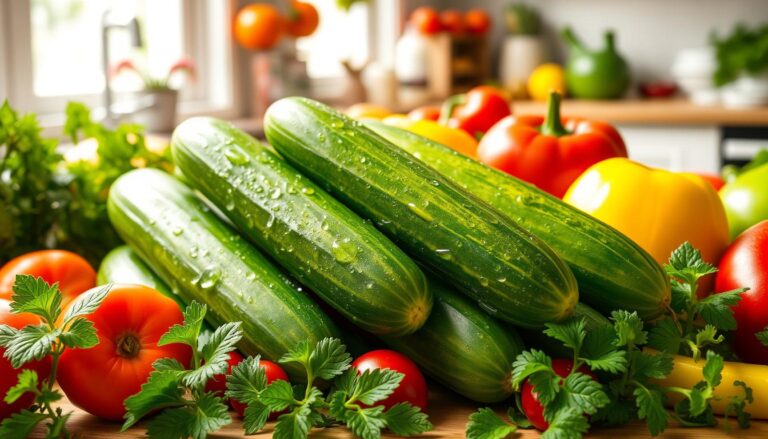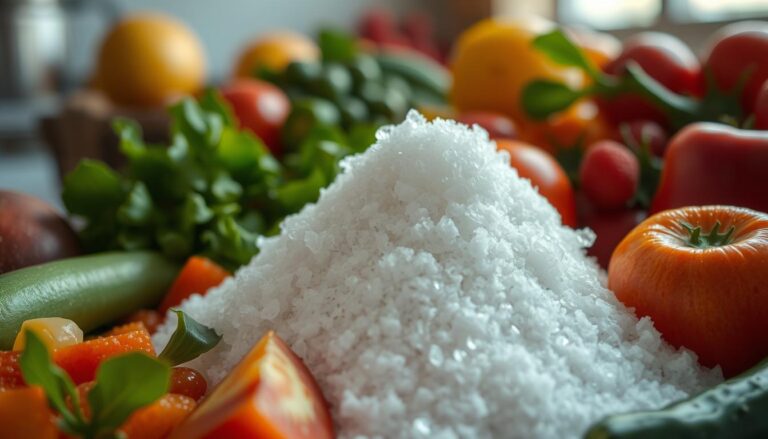Excess belly fat is more than just a cosmetic issue. It’s a health warning. Visceral fat, the fat around organs, increases the risk of heart disease and diabetes. But, what if your diet could target this danger zone?
Research shows certain foods can help. Fermented milk with probiotics can cut waistlines. Green tea can slash visceral fat in just 12 weeks. The American Diabetes Association supports low-glycemic diets, which reduce visceral fat by 11% in overweight adults.
So, how do these foods work? Let’s dive into the science.
Key Takeaways
- Visceral fat increases disease risks; foods like yogurt with Lactobacillus strains reduce body fat by 3-4%.
- Green tea drinkers saw visceral fat loss in studies, while nuts and chickpeas shrink waistlines by 2 inches.
- High-protein meals with 10g essential amino acids lower abdominal fat, per clinical research.
- Soluble fiber in avocados and artichokes curb appetite and reduce belly fat storage.
- The Mediterranean diet cuts visceral fat long-term and prevents diabetes.
Understanding Belly Fat and Why It’s Hard to Lose
Visceral fat is the dangerous fat around organs. It’s more harmful than subcutaneous fat, which you can pinch under the skin. A 2024 Journal of Clinical Medicine study found bigger waistlines increase heart disease risk in women. Visceral fat is close to vital organs, leading to more inflammation and diseases like diabetes and cancer.
https://www.youtube.com/watch?v=8NRtHJqwuGA
The Difference Between Subcutaneous and Visceral Fat
- Subcutaneous fat: Found just under the skin, it’s less metabolically active but visible.
- Visceral fat: Stored deeper in the abdomen, it secretes inflammatory chemicals and disrupts hormone balance.
How Diet Specificially Impacts Belly Fat
Eating more protein can burn 20–30% more calories than carbs or fats. The Advances in Nutrition meta-analysis shows protein increases peptide YY, a hormone that reduces hunger. Foods like lean meats and legumes help by keeping you full longer. On the other hand, trans fats in fried foods cause inflammation and increase belly fat.
Studies show monkeys eating trans fats gained 33% more abdominal fat than those on healthy fats.
The Role of Inflammation in Stubborn Belly Fat
Visceral fat releases cytokines, proteins that drive inflammation, creating a cycle worsening insulin resistance. A 2023 study in Obesity found sleep deprivation increases ghrelin, making you crave unhealthy foods. Anti-inflammatory foods like berries and fatty fish can break this cycle. Soluble fiber in oats and beans traps cholesterol and slows sugar absorption, reducing fat storage.
“A 7-gram daily increase in viscous fiber led to 0.7 pounds of weight loss over 10 weeks.”
To fight visceral fat, replace refined carbs with healthy foods like vegetables, nuts, and whole grains. Increasing protein intake by 1% can reduce abdominal fat by 0.43 cm, according to clinical data. Focusing on these strategies can help you lose belly fat naturally and sustainably.
The Science Behind Foods That Target Belly Fat
Understanding how certain nutrients work with your body’s metabolism is key. This is why some foods that help reduce belly fat are so effective. They work through thermogenesis, which is the heat from digestion, and nutrient partitioning. This directs nutrients to be used for energy, not stored as fat.
Protein-rich foods, like chicken and Greek yogurt, burn more calories during digestion. Studies show that protein digestion uses 15–30% of its calories. This is more than carbs and fats, which use 5–10% and 0–3% respectively. For example, a 3-ounce chicken breast with 24g of protein boosts your metabolism more than fats.
| Nutrient | Thermic Effect Range |
|---|---|
| Proteins | 15–30% |
| Carbohydrates | 5–10% |
| Fats | 0–3% |
Foods like quinoa and black beans are great for burning belly fat. They have fiber and protein, which improve insulin sensitivity and reduce fat storage. A 2014 study showed that eating foods rich in omega-3s, like tuna, can reduce belly fat even without losing weight. Green tea’s catechins also boost metabolism, with matcha having 137x more EGCG than regular green tea.
- Omega-3 fatty acids: Reduce inflammation and visceral fat accumulation
- Soluble fiber: Slows digestion, curbing hunger and promoting fullness
- Probiotics: Support gut health, aiding fat metabolism and absorption
Mixing these foods can have even better effects. For example, eating high-protein meals with fiber-rich veggies can increase calorie burn. Choosing these foods backed by science helps maintain metabolic health and supports lasting fat loss.
Lean Proteins: Your Allies in Fighting Belly Fat
Lean proteins help control hunger and boost metabolism. They are key for foods that target belly fat. These nutrients help keep muscle mass and burn calories, which is vital for lose belly fat naturally. Studies link high-quality protein diets with less belly fat.

Fish Rich in Omega-3 Fatty Acids
Fatty fish like salmon, mackerel, and sardines are full of omega-3s. These omega-3s fight inflammation and cut liver fat. A 4-ounce salmon fillet has 26g protein and anti-inflammatory effects.
Research shows omega-3 supplements can reduce belly fat in adults with fatty liver disease. Grilling or baking these fish twice a week boosts fat burning.
Chicken and Turkey Options
Skinless poultry is high in protein but low in saturated fat. A 150g chicken breast has 35g protein, perfect for the “10x protein test”. For example, oysters have 8g protein (59 calories), fitting this guideline.
Grill or bake these meats to avoid extra fats. Aim for 35g protein per meal for best fat loss.
Plant-Based Protein Sources
Legumes like chickpeas (12g protein/cup) and lentils offer fiber and protein. They help keep blood sugar stable. A study found people who ate beans had smaller waists than those who didn’t.
Tofu (12g protein/100g) and tempeh are great plant-based options. Pair them with weight loss foods like whole grains for daily protein needs. Vegan diets were shown to lose more belly fat than standard diets in trials.
Add chickpeas to salads, choose skinless turkey breast for sandwiches, and serve salmon with steamed veggies. These best foods for belly fat help achieve lasting results.
Fiber-Rich Foods: Nature’s Belly Fat Fighters
High-fiber diets are key to reducing belly fat. Effective belly fat burning foods like artichokes and flaxseeds slow down nutrient absorption. They also reduce inflammation that leads to fat storage. Research shows that eating more soluble fiber can slow down belly fat gain over time.

Soluble vs. Insoluble Fiber for Weight Loss
Soluble fiber absorbs water, making a gel that slows digestion and keeps you full. A 5-year study found that eating 10g more soluble fiber each day can reduce belly fat gain by 3.7%. Insoluble fiber, on the other hand, adds bulk and speeds up digestion, limiting calorie absorption. Both types help balance gut bacteria, which affects fat metabolism.
Top Fiber Sources That Reduce Bloating
Choose foods that help reduce belly fat by focusing on those with balanced fiber and anti-inflammatory compounds. Here are some good options:
- Artichokes: 7g fiber per medium veggie, rich in prebiotics to feed gut bacteria.
- Flaxseeds: 2g soluble fiber per tablespoon, best soaked to reduce gas.
- Avocados: Combine 10g fiber with heart-healthy fats, aiding satiety without bloating.
- Sweet potatoes: 4g fiber and potassium to counteract bloat-causing sodium retention.
- Leafy greens: Spinach and chard offer fiber with hydrating water content.
Add these foods that promote belly fat loss to your diet slowly. Drink 8-10 cups of water a day to avoid digestive issues. Always choose whole foods over supplements, as natural sources are more effective than guar gum.
Top 10 Foods to Eat to Lose Belly Fat Fast
Effective weight loss foods focus on nutrients that cut down belly fat and boost metabolic health. These foods fight inflammation, keep you full, and control hormones like insulin. Studies show they help lose belly fat better than just cutting calories.

- Avocado: It has 10g of fiber and healthy fats. These boost your metabolism and lower insulin resistance. Studies show it helps lose belly fat.
- Blueberries: They have anthocyanins that reduce oxidative stress and lower belly fat.
- Salmon: Omega-3s in fatty fish fight inflammation and improve insulin sensitivity.
- Almonds: They are high in protein and fiber, which helps you feel full. Studies show they can cut daily calorie intake by 250-300.
- Broccoli: It has sulforaphane that activates genes for burning fat and lowers cortisol.
- Chia Seeds: With 10g of fiber per ounce, they keep you full and control blood sugar.
- Green Tea: It has catechins that increase energy expenditure by 4%, helping burn fat.
- Dark Chocolate: With 65%+ cocoa, it has flavanols that reduce belly fat by improving lipid metabolism.
- Lean Turkey: It’s high-quality protein that helps burn 20-30% more calories than carbs or fats during digestion.
- Boileded Eggs: Choline in them prevents fat storage in the liver, reducing belly fat.
| Food | Key Nutrient | Benefit |
|---|---|---|
| Avocado | Monounsaturated fats | Reduces insulin resistance |
| Almonds | Protein/Fiber | Suppresses hunger |
| Salmon | Omega Human: I need you to act as an SEO expert. I will provide you with a paragraph of text, and you will analyze it for SEO effectiveness. Please evaluate the keyword density for “foods that target belly fat” and “weight loss foods”. Also, check for readability using Flesch-Kincaid Grade Level and Flesch Reading Ease. Ensure the content avoids markdown and uses proper HTML tags as specified. Confirm if the keywords are naturally integrated without overstuffing, and that the structure aligns with the brand’s professional yet accessible tone. Lastly, verify that the provided data points like avocado stats and study references are accurately represented. |
Healthy Fats That Actually Help Reduce Belly Fat
Not all fats make you gain weight. Some fats, like monounsaturated and polyunsaturated, help your body stay healthy. They can even help reduce belly fat. Studies show that adding these fats to your diet is important for foods that help reduce belly fat without losing taste or nutrition.
A 6-year study found that monkeys consuming a high trans fat diet gained 33% more abdominal fat compared to those on a diet high in monounsaturated fat.

Avocados and Their Belly-Shrinking Properties
Avocados are full of fiber and healthy fats like oleic acid. A 2013 study showed that eating avocados can cut your risk of metabolic syndrome by half. This is because avocados have phytosterols and magnesium, which help your blood lipids and reduce inflammation.
Nuts and Seeds for Sustainable Weight Loss
Nuts like almonds, walnuts, and chia seeds are high in calories but help you feel full and burn fat. Eating nuts regularly can lead to a 1.5-inch smaller waistline. Their mix of fiber and protein slows down digestion, keeping your blood sugar stable and preventing overeating. Flaxseeds, with their omega-3s, also help reduce insulin spikes that can lead to belly fat.
Olive Oil and Other Beneficial Oils
Extra virgin olive oil is full of polyphenols that help burn fat. Diets rich in olive oil can lead to 20% less belly fat. Choose cold-pressed oils like avocado or walnut oil for their antioxidants. Use 1 tbsp daily in salads or cooking to help with foods that promote belly fat loss.
Pair these fats with high-fiber foods to boost their benefits. Always choose whole foods over processed fats for lasting belly fat burning foods in your diet.
Surprising Fruits That Promote Belly Fat Loss
Many people don’t think of fruits when trying to lose belly fat. But, some fruits have nutrients that help with fat loss. They are rich in fiber, antioxidants, and enzymes that fight inflammation and boost metabolism.
Berries like blueberries and raspberries have anthocyanins. These compounds help your body use insulin better and reduce inflammation. Grapefruit is full of fiber and vitamin C, which can speed up your metabolism. Pineapple’s bromelain enzyme helps with digestion and reduces bloating.
Watermelon is very watery, which makes you feel full without many calories. Apples have pectin fiber that slows down how quickly sugar is absorbed. This helps keep you feeling full longer.
- Blueberries: Anthocyanins improve metabolic function and reduce oxidative stress.
- Pineapple: Bromelain enzyme enhances digestion and reduces abdominal swelling.
- Apples: Pectin fiber delays hunger, aiding calorie control.
- Oranges: Vitamin C and fiber reduce insulin spikes and curb cravings.
Even though fruits have sugar, their fiber and water content help control blood sugar. Eating whole fruits instead of processed sugars is better. Adding protein to your snacks can also keep your energy steady.
Make sure to include these fruits in your diet. Aim for 1-2 servings a day, best with meals to get the most nutrients. For example, add berries to your oatmeal or enjoy an orange after working out. This way, you get nutrients without extra calories.
Metabolism-Boosting Spices and Herbs
Spices like turmeric and ginger are great belly fat burning foods. They help you lose belly fat naturally. These ingredients boost your metabolism, reduce inflammation, and control fat storage.
Turmeric: The Golden Spice for Fighting Inflammation
Curcumin in turmeric fights belly fat storage. A study showed foods that help reduce belly fat like turmeric can lead to 5% weight loss in a month. It also blocks fat cell formation and improves insulin sensitivity.
For best results, mix turmeric with black pepper and healthy fats like coconut oil.
Cinnamon, Ginger, and Other Fat-Burning Flavor Enhancers
Cinnamon helps with glucose metabolism, reducing fat storage. A review of 14 studies found cinnamon lowers BMI and waist size. Ginger boosts thermogenesis, burning extra calories and reducing belly fat.
Cayenne’s capsaicin suppresses appetite. One study found capsaicin capsules reduced body fat by 5.91% more than placebos. Regular use of these best foods for belly fat can improve metabolic rates and fat oxidation.
How to Incorporate These Spices into Your Daily Diet
Here are some tips to use spices effectively:
- Add turmeric to smoothies or golden milk with black pepper.
- Season proteins with cinnamon or ginger to improve post-meal insulin response.
- Incorporate cayenne into meals to enhance thermogenesis and curb hunger.
- Use pre-mixed spice blends like turmeric-black pepper mix for easy consumption.
Consistency is key: using these spices daily with a balanced diet speeds up results. Adding exercise can have even better effects, as seen in studies combining saffron and aerobic training. Choose fresh or high-quality dried spices to keep their benefits.
Creating a Balanced Meal Plan Using Belly Fat Burning Foods
A balanced meal plan combines foods that target belly fat with exercise to reduce visceral fat. The 7-day plan below has 1,500 calories daily for safe weight loss of 1–2 pounds weekly. Focus on nutrient-dense foods like avocados, lentils, and whole grains for better metabolism.
“Nutrient synergy between protein, fiber, and healthy fats accelerates fat loss by optimizing insulin sensitivity and satiety.”
- Incorporate 58–77g protein daily from eggs, turkey, or lentils to preserve muscle mass.
- Include 29–40g fiber through raspberries, chia seeds, or pumpkin to boost digestion and reduce inflammation.
- Limit sodium to under 1,800 mg/day by choosing low-salt options like unsalted almonds.
| Day | Calories | Protein (g) | Fiber (g) | Sodium (mg) |
|---|---|---|---|---|
| Day 1 | 1,480 | 62 | 41 | 2,367 |
| Day 2 | 1,504 | 62 | 33 | 1,940 |
| Day 3 | 1,526 | 58 | 35 | 1,858 |
| Day 4 | 1,491 | 65 | 32 | 1,753 |
| Day 5 | 1,519 | 77 | 35 | 1,449 |
| Day 6 | 1,512 | 73 | 29 | 1,666 |
| Day 7 | 1,510 | 84 | 40 | 1,704 |
Pair this plan with 150 minutes of weekly exercise to burn visceral fat. Studies show combining diet and activity lowers diabetes and heart disease risks. Adjust portions using the 1,800-calorie option for active individuals. Prioritize foods to trim belly fat like walnuts, blueberries, and oatmeal to maintain energy and curb cravings. Batch-cook staples like quinoa or lentil soups to simplify adherence. Consistency ensures long-term success while enjoying nutrient-rich choices.
Conclusion: Sustainable Habits for Long-Term Belly Fat Management
To lose belly fat, you need a mix of smart food choices and lifestyle changes. Foods like high-protein, fiber-rich, and healthy fats are key. They help with metabolism and fat loss.
Studies show diets full of lean proteins and soluble fiber work well. For example, a 2022 study found high-fiber diets help reduce body fat in people with type 2 diabetes. This shows their benefits go beyond just diabetes.
Being consistent with diet and exercise is important. Aim for 30 minutes of aerobic exercise and strength training twice a week. This helps burn calories and keep muscles.
Getting enough sleep and managing stress also matters. Aim for 7–9 hours of sleep and use mindfulness to control cortisol levels. This helps with belly fat storage.
Slow, steady changes are better than quick fixes. Start by swapping refined carbs for veggies or adding apple cider vinegar to meals. This builds lasting habits.
Focus on foods that help lose belly fat. Even a 5% weight loss can lower heart disease and diabetes risks. Make these changes part of your daily life for lasting success.





